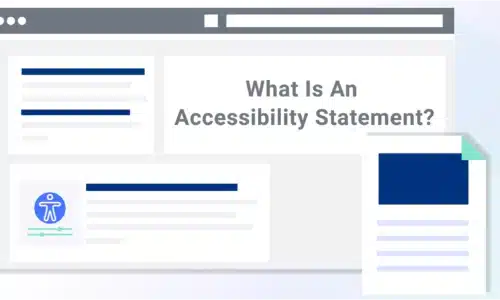An accessibility statement is an important policy that informs visitors about the steps you’ve taken to ensure your digital services and website are accessible to all users, including those with disabilities.
The policy needs to be easy to read and understand, honest and accurate about your inclusivity solutions or digital limitations, and include working contact information, and is impacted by some consumer protection laws.
In this guide, I will explain more about what an accessibility statement is and how you can make one for your website.
How To Make An Accessibility Statement
There are several ways to make an accessibility statement for your website, like using a reputable free template or more personalized generator.
You can also write your own accessibility statement, but this can be difficult.
These policies need to clearly explain what tools your site uses to increase its usability for all visitors and should be written in a way that’s easily digestible.
Here’s some tips to help you write your own:
- Tip 1: Write your policy using simple, straightforward language.
- For example, when rereading the content, ask yourself if everyone can understand it? Simplify what it says until your answer is yes.
- Tip 2: Format your policy in a way that’s easy to follow.
- For example, use clear headings for clauses, include a table of content, link to other documents as necessary, and proper spacing,
- Tip 3: Be honest about what accessibility guidelines you follow and what you have implemented while you’ve built and launched your website.
- For example, this is where you can state information like if your website intends to follow WCAG standards, and which conformance level you’re aiming for, A, AA, or AAA. Just be honest and transparent with your users.
- Tip 4: Be honest about what limitations your site or platform has.
- For example, if you’re hoping to achieve the highest WCAG standards over time but aren’t quite there yet on a practical level, that’s okay! Just be honest about what parts of your website aren’t there yet.
- Tip 5: When necessary, explain what you plan on doing to address the limitations without overpromising or being inaccurate.
- For example, tell your users specifically what you’re working on to address the known limitations, like adding more subtitles, or securing a contrast checker.
- Tip 6: Include contact information and follow up on whatever channel is included.
- For example, provide an active email address or a contact form, this ensures user requests, questions, and concerns are adequately addressed.
Depending on what laws you need to follow, you might consider having an attorney review your policy, especially if you choose to take the hard route and write it yourself.
What Is an Accessibility Statement?
An accessibility statement is a document that informs users about your organization’s commitment to digital inclusivity.
It explains what you do to make sure your website is accessible to all visitors, including those with disabilities.
These statements communicate what accessibility standards you might follow, like the Web Content Accessibility Guidelines (WCAG), which tools you’ve implemented, limitations your site might have, and more.
It also helps users know how to contact you if they have requests or concerns.
Are Accessibility Statements Legally Required?
While accessibility statements are not always legally required in the U.S., it can help businesses meet guidelines outlined by the Americans with Disabilities Act (ADA).
In Europe, originations are required to have one of these statements as written by the European Accessibility Act (EAA).
Types of Web Accessibility Standards
There are several types of web accessibility standards:
- WCAG: The Website Content Accessibility Guidelines is commonly used by U.S. companies to commit to because it assists with the ADA.
- ATAG: The Authoring Tool Accessibility Guidelines are often used by developers and web content creators.
- UAAG: The User Agent Accessibility Guidelines are often used by web browsers and other software that renders web content.
Accessibility Tools for Websites
Common accessibility tools used by websites to promote a more equal user experience include:
- Automated scanners: Tools like Accessibility Checker can scan websites for common accessibility issues.
- Contrast checkers: Some tools can help ensure your color contrast across your website is visible to users with vision impairment or other issues.
- Keyboard navigation tools: These help users navigate websites using only keyboards and ensure that all content is accessible using a mouse.
- Captioning and multimedia tools: These create captions and subtitles for videos and other media to ensure hearing impaired users can still enjoy the content.
You might also use manual testing or rely on tools that require human interaction, and those should also be mentioned in your statement to keep your users properly informed.
Benefits of Having an Accessibility Statement
Having an accessibility statement is essential for any website that wants to succeed.
It shows your commitment to inclusivity.
This not only builds trust with users, but it also literally helps ensure your services are available to more people.
It may reduce your legal risk.
While accessibility statements aren’t necessarily legally required, they do help organizations align with laws and regulations outlined by the Americans with Disabilities Act and the European Accessibility Act.
It may help enhance your brand image.
Showing users that you’re committed to accessibility and inclusivity can help boost your brand’s reputation because you’re promoting equitability and equality.
What Goes into an Accessibility Statement
A common accessibility statement will include all the following sections, but you can adapt this as necessary based on the needs of your unique business.
Commitment to Accessibility
Your accessibility statement should start with a clear declaration expressing your dedication to ensuring your website and digital products are inclusive for all users.
This section should be easy to read, honest, and prominently displayed.
Accessibility Standards
Next, your accessibility statement should explain what specific standards or guidelines your company follows, like the various WCAG levels and ADA Accessibility Standards.
Be thorough and honest in this section and explain what following these guidelines means for your users.
Known Limitations
It’s important that you list all known limitations in your accessibility statement.
Informing users about accessibility limits and areas where your website or content aren’t yet fully accessible helps keep them properly informed.
This way, they know what to expect when using your website or other digital products.
Company Contact Information
Make sure your accessibility statement has clear contact information available so users can reach out to you with questions, comments, or support.
Adding a working email address or form to this section of your policy also helps streamline receiving and responding to requests for various accommodation.
Testing and Evaluation
It’s a good idea to add a clause to your statement explaining how you test your website/digital service for accessibility issues and other compatibility considerations.
This legitimizes your efforts and once again keeps users informed about all you’re doing to create an inclusive website.
Future Goals
Consider adding a clause to your accessibility statement that lists your future goals for improving the accessibility of your website, and how you’ll address identifies limitations.
This shows users that you care about these issues and you’re continuing to put in efforts to make improvements to your website and services.
Technologies and Compatibility
You should also consider all third-party technologies your website uses and list any known compatibility considerations that exist in a clause in your accessibility statement.
This can inform users about issues or limitations that are beyond your control but still impact your site.
Mention Accessibility Expertise
If your organization uses any expert resources to enhance accessibility, mention it in a clause in your statement so your users can learn more about your efforts.
This once again helps show users that you’re taking the right steps to ensure your services are inclusive for everyone.
Where To Post Your Accessibility Statement
Post your accessibility statement in any of these easy to find locations across your site:
- Website footer: Because your website footer is a static part of your website that never changes, it’s the perfect spot to link to important documents like an accessibility statement.
- Help or Legal page: Users will likely navigate to your help or legal page to find your important policies and legal documents, so ensure you also link your accessibility statement on this page.
- Homepage: Your accessibility statement should appear on your homepage so when users end up here, they can easily find the information and have the best possible user experience while using your platform.
Accessibility Statements Matter
Creating a unique accessibility statement for your website is an important part of keeping all of your users properly informed.
These documents help highlight your commitment to inclusivity and show your users that you respect them all.


